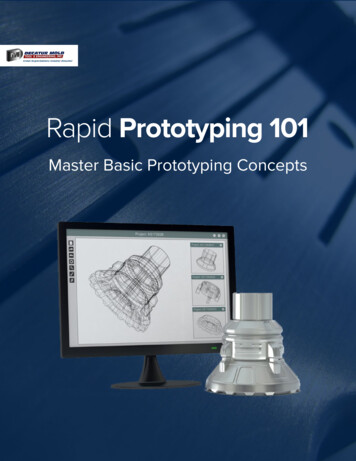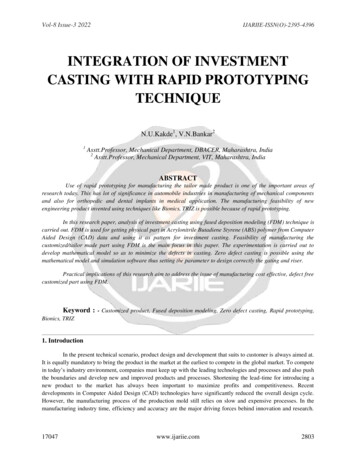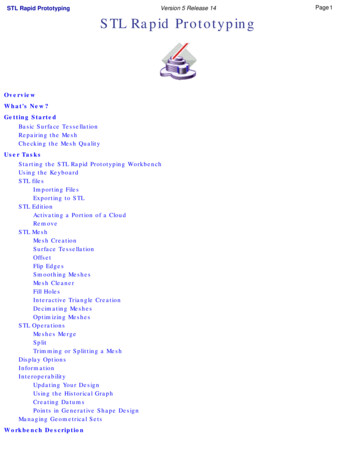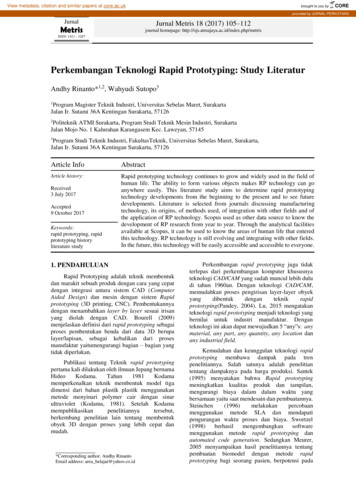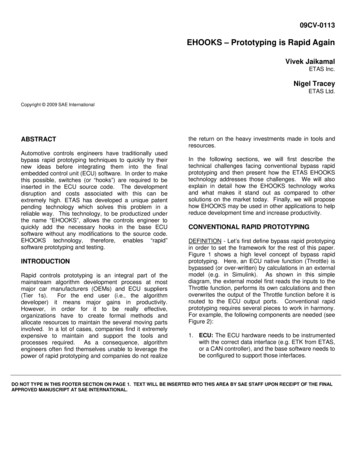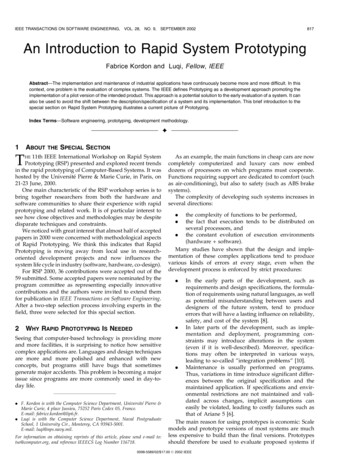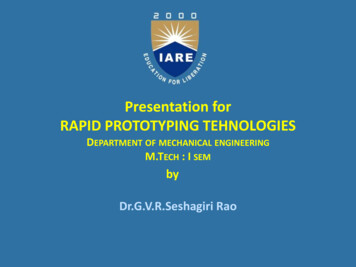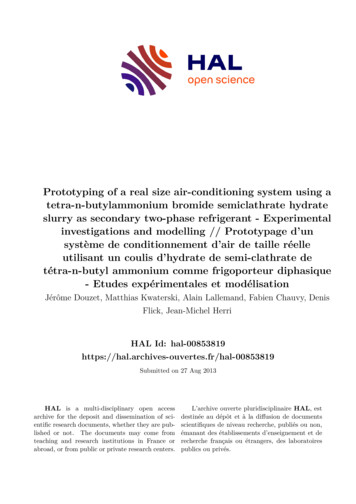
Transcription
Prototyping of a real size air-conditioning system using atetra-n-butylammonium bromide semiclathrate hydrateslurry as secondary two-phase refrigerant - Experimentalinvestigations and modelling // Prototypage d’unsystème de conditionnement d’air de taille réelleutilisant un coulis d’hydrate de semi-clathrate detétra-n-butyl ammonium comme frigoporteur diphasique- Etudes expérimentales et modélisationJérôme Douzet, Matthias Kwaterski, Alain Lallemand, Fabien Chauvy, DenisFlick, Jean-Michel HerriHAL Id: 0853819Submitted on 27 Aug 2013HAL is a multi-disciplinary open accessarchive for the deposit and dissemination of scientific research documents, whether they are published or not. The documents may come fromteaching and research institutions in France orabroad, or from public or private research centers.L’archive ouverte pluridisciplinaire HAL, estdestinée au dépôt et à la diffusion de documentsscientifiques de niveau recherche, publiés ou non,émanant des établissements d’enseignement et derecherche français ou étrangers, des laboratoirespublics ou privés.
To cite this version:Jérôme Douzet, Matthias Kwaterski, Alain Lallemand, Fabien Chauvy, Denis Flick, et al. Prototyping of a real size air-conditioning system using a tetra-n-butylammonium bromide semiclathratehydrate slurry as secondary two-phase refrigerant - Experimental investigations and modelling //Prototypage d’un système de conditionnement d’air de taille réelle utilisant un coulis d’hydratede semi-clathrate de tétra-n-butyl ammonium comme frigoporteur diphasique - Etudes expérimentales et modélisation. International Journal of Refrigeration, Elsevier, 2013, 36 (6), pp.616-1631. 10.1016/j.ijrefrig.2013.04.015 . hal-00853819
Prototyping of a real size air-conditioning system using a tetra-n-butylammoniumbromide semiclathrate hydrate slurry as secondary two-phase refrigerant –Experimental investigations and modellingJérôme Douzeta, Matthias Kwaterskia, Alain Lallemanda, Fabien Chauvya, Denis Flickb, JeanMichel Herria,*aÉcole Nationale Supérieure des Mines de Saint-Etienne, Centre SPIN, département ProPICE,UMR CNRS 5307 Laboratoire Georges Friedel, 158 cours Fauriel, 42023 Saint-EtienneCedex 02, FrancebAgroParisTech, UMR 1145 Ingénierie Procédés Aliments, 16 rue Claude Bernard, 75231Paris Cedex 05, France* Corresponding author. Tel.: 33 477420292; fax: 33 477499692E-mail address: herri@emse.fr (J. M. Herri).AbstractAmong innovative processes developed in the field of refrigeration systems, technologies areencountered which are based on the application of Phase Change Materials (PCM) for thestorage and transportation of energy. PCM are often provided by means of slurries. In the airconditioning system presented here, a slurry of semi-clathrate hydrate crystals based on Tetran-Butyl-Ammonium Bromide (TBAB) is used as secondary refrigerant. The production of theslurry can be smoothed over day and night. Upon storage, the slurry can be distributed to endusers, and molten to recover the cooling capacity. By adaption of a standard refrigeration1
technology, it is at first demonstrated that an air-conditioning system can be established byreplacing the standard refrigeration fluid by a slurry of TBAB based semi-clathrate hydrate.Furthermore, the study attempts to model the settling of particles within the storage tank,aiming at gaining some insight in their complex migration processes obtained during theproduction and distribution steps.Keywords: Air-conditioning; Technology transfer; Hydrate slurries; Phase Change Material;TBAB; Storage ModellingNomenclatureLatin symbolsAs, tanksurface area of the tank (m2)Cnumber density of hydrate particles, i.e. number of hydrate particles per unit ofvolume (m–3)cpspecific heat capacity at constant pressure (J kg–1 K–1)dmean equivalent diameter of hydrate particles (m )Deqequivalent diffusivity (m2 s–1) dishhydspecific heat of dissociation/melting of the semi-clathrate hydrate (also calledthe “latent heat” of hydrate melting) (J kg–1)gacceleration of gravity on an average height the earth’s surface (m s–2)hspecific enthalpy (J kg–1)hinsulationglobal heat transfer coefficient (trough lateral insulation) (W m–2 K–1)Henthalpy, (J)2
mmass (kg)m&mass based flow-rate (kg s–1)Mmolar mass (kg mol–1)ptanktank perimeter (m)Pthermal power (W)ttime (s )Tthermodynamic temperature (K)vvelocity (m s–1)Vvolume (m3)wmass fraction (-)ww, freeliquid phase mass fraction of water in excess with respect to the congruentpoint (“free water”) (-)zcharge number (-)Zspatial coordinate indicating the height position in the storage tank (m)Greek symbolsβ mHmass-based hydrate phase fraction, β mH m H /(m H m L W ) (-)βVHvolume-based hydrate phase fraction, β mH V H /(V H V L W ) (-) difference in generalϑcelsius temperature ( C)λeqequivalent thermal conductivity of the slurry (W m–1 K–1)µdynamic viscosity (Pa s)νwhydration number (-)νstoichiometric coefficient (-)3
ρdensity (kg m–3)0initial conditionSubscriptsAanion, here more specifically A Br–Ccation, here more specifically C (n-C4H9)4N cgrconditions at congruent melting and dissociation dsemi-clathrate hydrate compound based on tetra-n-butylammonium bromide,i.e. abbreviation for (n-C4H9)4NBr·ν w H2O where the hydration number can be 26 or 38, i.e.,the index “hyd” can refer to type A and type B TBAB-semi-clathrate hydrate, depending onthe contextinletreferring to an inlet to the crystallisermaxmaximum valueoutletreferring to an outlet from the crystallisersetsettlingsolsolution, here in particular the liquid aqueous solution of tetra-n-butylammonium bromideTBABtetra-n-butylammonium bromidewwater4
w, freereferring to ”free water“, the water being present in the liquid phase in excessto the stoichiometric composition of a hypothetical presence of a semi-clathrate hydrate phasein the liquid phaseSuperscripts indicating an arithmetically averaged quantity pure componentHhydrate phase, here more particularly a semi-clathrate hydrate phaseLliquid phaseLwaqueous liquid phaseSsolid phaseVvapour phase (concerning primary fluid)1. IntroductionThe increasingly widespread use of air-conditioning systems all over the world has a directimpact on the global energy demands with respect to both the overall average electricityconsumption over the years and the fluctuations of the energy consumption between days andnights. A special domain of application concerns the air-conditioning of spaces requiring highcooling capacities. With regard to the European market in particular, the chillers possessingcooling powers in the ranges of (20-500) kW or (500-1200) kW are important in this context.Coolers with these specifications are typically used for the air-conditioning of large building,public rooms or industrial buildings.5
The principle of techniques based on Phase Change Materials (PCM) consists in storingenergy by using the change in enthalpy accompanying the corresponding phase transition andto subsequently distribute the PCM, upon which the phase change has been performed, ondemand. In such a process, the energy is preferably stored during periods in which the energyneeds are low, i.e. generally at nighttime. Later, when the cooling capacity is needed, usuallyin the daytime, the PCM is distributed in accordance with the special requirements of the endusers. In addition, the thermodynamic regime of air-conditioning machines can be optimisedsince the night-time is a more appropriate period for the operation of thermodynamic cyclesdue to its lower average outside temperature.A further advantage of using a PCM over using a classical refrigerant only is the possibility ofconfining the primary cooling cycle (i.e., the complete unit containing all the compressors,valves, heat exchangers and other technical devices) and thus, the primary refrigerant fluid, ina single localised space. This space could e.g. be a machine room which is exclusivelydedicated to the generation of the secondary heat exchange medium. By smoothing theelectrical consumption over 24 hours, the cooling cycle, hereafter referred to as “primaryloop”, can be optimised in order to allow the decrease of the total amount of primaryrefrigerants, and hence diminishes their ecological impact. In this context, especially therefrigerants being subject to the Montreal and Kyoto Protocols are to be mentioned. The“cold” is distributed to the end-user via a secondary loop in which the PCM is directlyconducted in the form of a slurry. Alternatively, the energy removal in this type of cycles iscarried out by using another liquid heat exchange medium, e. g. water. In the latter case, thisthird heat exchange medium would be used in a tertiary cycle being brought in heatconducting (diathermal) contact with the secondary PCM based cooling cycle. The PCMwould in that event remain in the machine room as well.6
Phase change materials based on ice slurries have been developed by several companies forapplications in the domain of refrigeration, i.e., for cooling at Celsius temperatures below zero.They benefit from the large enthalpy of fusion due to the breakup of the hydrogen bondsbetween the water molecules. In those types of refrigeration plants, water is used as coolingmedium, which is crystallised in the form of ice. The melting point and, hence, the operationtemperature can be lowered by adding appropriate additives, such as alcohols. Different typesof ice slurry generators have been developed (Meunier et al., 2007). Those ones holding asignificant market share are the scraped surface heat exchangers, as for example the Sunwellsystem (Gibert, 2006) or, like in this work, the Heatcraft generator (Compingt et al., 2009).However, for applications above 0 C, such as for air-conditioning, the use of ice slurries is nolonger applicable: the melting point of ice can not be shifted to positive Celsius temperatures.Several authors (Lipkowski et al., 2002; Obata, et al. 2003; Oyama et al., 2005) have shownthat semi-clathrate hydrates formed by certain quaternary ammonium salts can be used asPCM for air-conditioning applications. In fact, these solid compounds possess meltingtemperatures above 0 C, and, due to their crystallographic structure, which is based on a Hbonded framework, the values of their dissociation enthalpies are relatively high.The deployment of the technology needs to be accompanied with a fundamentalunderstanding of the behaviour of the slurry in the different steps of the overall process. Toachieve this aim, it is required to not only investigate the generation of the slurry in thecrystalliser, but also its storage in the tank as well as its distribution over the various loops asfunction of time. Studies on the heat transfer rates in processes using TBAB based semiclathrate hydrate slurries have been conducted for different experimental/technical7
configurations. In particular, results on the heat transfer in pipes (Wenji et al, 2009; Ma et al.,2010; Kumano et al., 2011b) or on the heat transfer in plate heat exchangers (Ma and Zhang,2011) have been published. The distribution of the slurry in particular plants has beeninvestigated by means of rheological studies (Darbouret et al., 2005b), studies on the flowcharacteristics (Kumano et al., 2011a) and pressure drop experiments in pipes (Ma and Zhang,2012).In the present work, we focus on the storage tank which is the location where the settling ofthe hydrate particles takes place. A numerical model is proposed to predict the evolution ofthe hydrate content within the plant in both time and space as well as to estimate the overallstorage cooling capacity. The model takes into account the natural settling of the hydratecrystals as function of their density. Furthermore, the storage tank is subjected to fluidcirculations with both the crystalliser and the end-user units which disturb the settling.2. Methods and Materials2.1.Principle of the air-conditioning system using a TBAB semi-clathrate hydrateslurryZhang et al. (2009) have presented a literature survey on several PCM. Tetra-n-butylammonium bromide (TBAB), in the form of an aqueous solution, is an appropriate candidatebecause of its availability at a moderate price, and the relative high melting temperature (up to12.4 C) and rather large heat of dissociation of the corresponding semi-clathrate hydrateswhich can be formed. Indeed, together with water molecules in aqueous solution, TBAB is8
able to generate crystals of semi-clathrate hydrate compounds which are formed according tothe reverse reaction of the general dissociation equilibriumCν C Aν A ν w H 2 O (S H) ν w H 2 O (L w ) ν C C zC (L w ) ν A AzA (L w )(1)In the particular case of TBAB with C (n-C4H9)4N and A Br- considered here, thestoichiometric coefficients ν C and ν A as well as the charge numbers zC and z A of thecorresponding ions are unity. Different numerical values have been reported in the literaturefor ν w , the stoichiometric coefficient of water. This quantity ν w , when related to onestoichiometric unit of the salt also referred to as the hydration number, corresponds to a givensemi-clathrate hydrate compound. Whereas Dyadin and Udachin (Dyadin and Udachin, 1984)for example report four different semi-clathrate hydrates of hydration numbers ν w 24, 26, 32,36, Shimada and co-workers (Shimada et al., 2005) found only two kinds of hydrates, referredto as type A and B, respectively, with ν w 26 and 38.When dispersed in the surrounding liquid aqueous solution phase, the semi-clathrate hydratecrystals form a slurry that can be used as a PCM according to formation/dissociationequilibrium defined in Eq. (1). The structure of these compounds is similar to the structure ofice. Hence, when being used as a semi-clathrate hydrate slurry in cold storage applications, inan analogue way as in the case of an ice slurry, the storage is based on making use of theenergy of the hydrogen bonds between the water molecules. However, in contrast to thelattice structure of ice, the presence of the quaternary ammonium allows for stabilising thethree-dimensional molecular network at a temperature superior than 0 C (Shimada et al.,2005). In Fig. 1 the crystallisation temperature at equilibrium is plotted as function of themass fraction of TBAB at 0.1 MPa. The two curves correspond to the two differentmodifications of semi-clathrate hydrates mentioned above with hydration numbers of ν w 269
and 38, respectively, as they have been described by Shimada et al. (Shimada et al., 2005).The authors have named the compounds semi-clathrate hydrates of type A and B, respectively.The specific enthalpy of dissociation dishhyd according to the reaction described by Eq. (1)amounts to about 193 kJ kg–1 for the semi-clathrate hydrate of type A, and 200 kJ kg–1 for thehydrate of type B, respectively (Obata et al., 2003; Oyama et al., 2005).Fig. 1 H-Lw Phase diagram of TBAB hydrates at ambient pressure (Darbouret, 2005a).In Table 1, the cooling capacities of a given mass of two cooling medias liquid water andTBAB semi-clathrate hydrate slurries, are compared in terms of their corresponding enthalpychange H . In the left two columns of Table 1 data on the average change in enthalpy Hfor generating a temperature change T of 4 K and 6 K, respectively, in a mass of mwLw ofchilled water are listed. The water possesses an initial temperature ϑ0 between 4 C and 8 C,10
which is typical for air-conditioning systems. These data are compared in the following threecolumns to data on the corresponding enthalpy changes that 1 kg of a TBAB semi-clathtratehydrate slurry of different mass based hydrate phase fractions of 10 %, 20 % and 30 %undergoes. Thereby, the mass based phase fraction β mH of the semi-clathrate hydrate phase isdefined according to:β mH mHm H m Lw(2)where m H refers to the mass of the semi-clathrate hydrate phase and m L w for the mass of theliquid aqueous solution phase in the slurry. Whereas m H does ideally refer to a pure phase,the semi-clathrate hydrate compound, when according to Eq. (1) only a single semi-clathrateH, where the index “hyd” is anof fixed hydration number ν w is formed (i.e., m H mhydabbreviation for “(n-C4H9)4N Br·ν w H2O”), the liquid phase consists of the aqueous TBABLwsolution (i.e. m Lw msol, where the index “sol” is an abbreviation for the aqueous binarysolution of TBAB). It has to be remarked that although the initial temperatures of the twodifferent cooling media are in the same region, the nature of the enthalpy change is different.For chilled water, the enthalpy change leads to a change in temperature but not to a phasetransition. Hence, the averaged quantity H corresponds to what is referred to as “sensibleheat” and is expressed by: H mwLw c po,,wLw T(3)where mwL w is the mass of the portion of liquid water, c po,,wL w the average specific isobaric heatcapacity of pure liquid water at a Celsius temperature around the reference temperature ϑ0and T the temperature change accompanying the average enthalpy change H . In contrast,the average enthalpy change experienced by the hydrate slurry, correspond to H -values thatdescribe the simultaneous phase change and chemical dissociation reaction of the semi-11
clathrate hydrate according to Eq. (1). In other words, this quantity, also called “latent heat”,is given by:()LWHH H mhyd dis hhyd β mH mhyd msol dis hhyd (4)where dis hhyd stands for the specific enthalpy of dissociation at the dissociation temperatureand at ambient pressure. Eq. (4) illustrates, that the H -values compiled in Table 1 for thehydrate slurry as cooling medium do not include the contribution arising from the sensibleheat, but do instead only take into account the contribution from the combined phase andchemical equilibrium described by Eq. (1). For air-conditioning systems based on the use ofchilled water, it becomes clear from Table 1 that for a portion of water of mass mwL w 1 kg andan increase in temperature of 5 C, the corresponding change in enthalpy amounts to about 20LwHkJ kg–1. In contrast, the same portion of mass mhyd-slurry mhyd msol 1 kg of a slurry basedon β mH 20 % of TBAB semi-clathrate hydrates, is capable of providing an enthalpy changewhich is twice the value obtained for the previous case of chilled water. This is particularlyremarkable if it is realised that for the evaluation of the cooling potential of the slurry only theeffect of the dissociation the semi-clathrate hydrates (“latent heat” of the solid phase) hasbeen considered here.Table 1Comparison between the average enthalpy changes H undergone by 1 kg ofchilled liquid water and 1 kg of TBAB based hydrate slurries at ϑ0 [4,8] Cmwo, Lw 1 kg of chilled water mhyd-slurry 1 kg of TBAB semi-clathrateat ϑ0 [4,8] C experiencing hydrates slurries with mass based hydratea temperature change T ofphase fractions β mH of H kJ4K6K10 %20 %30%172520406012
The densities amount to 1080 kg m–3 for the hydrate crystals of type A and 1070 kg m–3 forthe hydrate crystals of B, respectively (Oyama et al., 2005). At temperatures in the interval of10 C and 24 C and for a TBAB mass fraction in the aqueous liquid phase between 0.2 and0.4, the corresponding density of the aqueous solution of TBAB varies from 1021 kg m–3 to1039 kg m–3 (Darbouret, 2005a; Obata et al., 2003; Belandria et al., 2009). As a result, thehydrate particles use to sink down in the aqueous solution and can settle at the bottom of thereactor. Therefore, the slurry can become inhomogeneous, especially in non-stirred zones.This phenomenon needs to be taken into account when designing the apparatus, particularlywith regard to the storage tank.2.2.Technological description of the installationWe have built and instrumented our own prototype by adapting a technology designed for iceslurries and available, on the European market, from the company Heatcraft-Europe. However,in this prototype plant, the PCM fluid has been exchanged for a tetra-n-butyl ammoniumbromide (TBAB) aqueous solution. This technology is comparable to the one developed andcommercialised by JFE Engineering Corporation, Japan (Takao et al., 2001; Takao et al.,2004; Mizukami, 2010, Ogoshi et al., 2010). The first prototype of JFE EngineeringCorporation was built in 2005 and to this day, approximately 10 systems with a coolingcapacity of up to 2 MW have been sold. In general, the Japanese company has transformed atraditional air-conditioning system by using cold water storage tanks and severalintermediates loops and fluids (up to 4) (Ogoshi et al., 2010).The flowsheet of the prototype constructed in our group is shown in Fig. 2. First of all, theexperimental setup is composed of a primary and a generation loop. After, in the utilisation13
loop, the slurry is distributed to the end-user. The capacity of the installation corresponds tothe capability to provide the air-conditioning for four rooms located on three different floors(total surface area of approximately 145 m²).Fig. 2 Basic scheme of the (full size) complete/overall installation.The primary loop is a classical cooling cycle composed of a compression, condensation,expansion and evaporation stage/unit, respectively, of a primary cooling fluid (refrigerant). Inthe current unit, the HydroFluoroCarbon (HFC) R407C is used for that purpose. Thecondensing unit (Scroll compressor condenser) is located outside the building to liquefyR407C at elevated pressure (around 1 MPa) and ambient temperature. The aqueous solutionof TBAB is crystallised in the hydrate generator by removing energy in the form of heat bymeans of the evaporating R407C fluid. The condensing unit is a standard model fromLENNOX with a cooling capacity of 29.3 kW (electric power consumption of 13.8 kW).After passing through the expansion valve, the R407C fluid enters the heat exchanger of thehydrate generator, a schematic representation of which is depicted in Fig. 3. The heat14
exchanger is composed of five plates constituting an internal flow loop in which the R407C isevaporated. The temperature is controlled on both sides of the five plates, respectively, whichin turn are in direct contact with the TBAB solution. On the surface of each of the two sidesof the plates the liquid solution undergoes a phase transition to the solid state and hence, ispartially converted into semi-clathrate hydrate. As a result, the hydrate generator is composedof 6 parallel connected stages separated by 5 exchanger plates. Each stage is sized for acooling capacity of about 5 kW to 6 kW in the original refrigeration application (by usingR404A as primary heat exchange fluid and ice slurries as secondary cooling medium). Thesemi-clathrate hydrate crystals tend to accumulate and stick on the surface of the plates, fromwhere they are taken off by rotating scrappers. This technology, further details of which canbe found in literature (Ben Lakhdar and Melinder, 2002; Ben Lakhdar et al., 2005; Compingtet al., 2009), is supplied by the company HeatCraft (Genas, France). At a height of 0.75 m anda diameter of about 1 m, the hydrate generator possesses an internal volume of 0.2 m3.15
Storage TankPrimary loop(R407C)abOne exchangerplateccda: Slurry circulation stageb: Rotating Scrapperc: Refrigerator plate surfaced: Evaporating zone of R407CFig. 3 Schematic representation of the hydrate generating unit.The storage tank and the hydrate generator are connected via a so-called generation loop. Theliquid solution is sucked at the top of the storage tank where the mass-based hydrate phasefraction is lower. Since the density of the hydrate particles is slightly higher than the density16
of the residual liquid solution, the solid particles tend to settle in the tank, especially if theslurry is unstirred. The tendency is that the liquid phase (or, more precisely, a suspension withlower hydrate phase fraction) is accumulated at the top of the tank whereas the crystalssediment at the bottom, leading to a slurry with higher hydrate phase fraction. The tank usedin our experimental setup is 2.5 m height and possesses volume of about 2 m3. It is entirelymade of stainless steel and insulated with a nitrile rubber jacket/coating of 19 mm thickness.The storage tank is filled with a 39 wt% TBAB aqueous solution, which is close to theconcentration at the congruent melting and dissociation point of the type A TBAB semiclathrate hydrate at wTBAB, cgr 40.77 %, where the corresponding phase transition temperatureamounts to ϑhyd, fus, cgr ϑhyd, dis, cgr 12.4 C (Darbouret, 2005a) as can be seen in Fig. 1.The secondary flow loop is the network to distribute the slurry to the end-user. The slurry issucked from two different levels of the storage tank. The volumetric pump P1 (Fig. 4)provides the flow and maintains the flow-rate in the loop by sucking the slurry at the bottomof the storage tank. At this level the phase fraction of semi-clathrate hydrates can attain thegreatest values of up to (40-50) wt%. Due to the high solid phase fraction, the semi-clathratehydrate slurry possesses the relatively greatest cooling capacity at the bottom of the tank. Forthat reason, it is very important that a significant portion of the hydrate suspension used forthe secondary cycle is withdrawn at that location. However, at such a solid fraction, theviscosity is too high for the slurry to be treated by the pump without difficulties. Therefore,the solid phase fraction needs to be reduced to a value of (20-30) wt% to end up at areasonable viscosity (Darbouret, 2005a). The slurry is diluted by using another pump P2which sucks the remaining portion of liquid for the secondary cycle or, more precisely, aslurry of lower hydrate phase fraction, at the top of the storage tank. The stream originatingfrom this exit is combined with the bottom stream just in front of the position at which the17
pump P1 is located (Fig. 4). Thus, the pump P2 serves as a means that allows particularly forcontrolling the volume fraction of the solid particles in the secondary loop. In practice, theflow rate of P2 is regulated in such a way that it does not exceed the flowrate imposed by P1.With regard to the material, this loop is made of cooper brass pipes of 40 mm internaldiameter and a length of approximately 100 m. It distributes the slurry to the rooms to be airconditioned.The characteristics of the pumps are as follows. Pump P1 is a lobes pump of type TLS 1-40provided by INOXPA which possesses a nominal power of 1.1 kW and a maximum flow-rateof 8 m3 h–1. Pump P2 is a centrifugal pump from INOXPA, model ESTAMPINOX EFI 2003,with a power of 0.37 kW and a measured flow-rate at 30 Hz of 3 m3 h–1. Pump P3 is a lobespump from INOXPA of type TLS 3-50 having a 3 kW power output and a maximum flowrate of 30 m3 h–1.The end-user fan coils implemented in the setup are standard model heat exchangers fromLENNOX . They are connected to the distribution flow loop via brass pipes of 10 mminternal diameter. A small pump HXL 63-15P provided by SALMSON, is installed in each ofthe supply lines of the corresponding fan coils. The fan coils cool down the room by meltingthe hydrate slurry. Three floors have been air-conditioned through a total of 7 fan coils.Whereas the 1st floor has been air-conditioned by means of three fan coils, the 2nd and 3rdfloor are equipped with two fan coils each. One of these exchangers is additionally endowedwith temperature sensors (Fig. 4).2.3.Instrumentation18
A schematic representation of the experimental setup in the form of a flow sheet diagram isshown in Fig. 4.HT4HHH3th floorR407CHydrate SlurryT,PHTemperature (T) or Pressure (P) SensorCoriolis flowmeterT5T9HT8HT3nd2 floorHHHHHHHHT,PT,PT6Condensingunit1st floorT2Fan HP1Fig. 4 Scheme of the full size installation, including in particular the locations of the sensors.To measure and control the temperature, Pt100 type temperature sensors have been used. Thesensors are screwed on brass connectors which in turn are brazed on the cooper pipes. Thesensor tip is located in the pipe. The pressure transducers are piezo-resistive transmittersprovided by KELLER. They are fixed to the pipe in the same way as the temperature sensors19
and serve as devices for monitoring the pressure in the primary loop and thereby forcharacterizing the state of the R407C. In order to measure the flow rate, two Coriolis flowmeters from MICRO MOTION have been installed. The first one is placed in the primaryloop, whereas the second one is incorporated in the generation loop. The location of the lastmentioned flow meter can be changed allowing for incorporating it into the utilisation loop.2.4.General design of the installationThe PCM slurries can be stored which allows for producing the cold energy during the night.Therefore the size of the cooling machines can be reduced. As a consequence of this, the plantcan be run continuously, at a constant rate, instead of working only during the peak demand.Moreover, the average outdoor temperature is lower at night-time than in the daytime whichleads to a better energetic balance of thermodynamic machines. Finally, depending on thelocal policies, the electricity could also be available at a lower price during night than duringthe day. Fig. 5 plots the histogram of the cooling capacity of a typical air-conditioning plantdesigned for cooling a room of 145 m2 with the peak of cooling demand during the day. Theenergy need can be managed by storing the slurry during the night and melting it in thedaytime.20
Fig. 5 Histogram of the management of the air-conditioning cooling capacities by usingenergy storage (Dumas, 2002).Our prototype has a storage tank of 2 m3. If the tank is homogeneously filled with a TBABsemi-clathrate hydrate slurry containing 30 wt% of solid phase, it is able to store a
L'archive ouverte pluridisciplinaire HAL, est destinée au dépôt et à la diffusion de documents scientifiques de niveau recherche, publiés ou non, émanant des établissements d'enseignement et de recherche français ou étrangers, des laboratoires publics ou privés. Prototyping of a real size air-conditioning system using a
